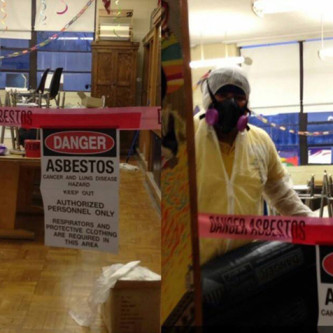
By Bill Walker

Ask them! The Asbestos-Containing Materials in Schools Rule, pursuant to the Asbestos Hazard Emergency Response Act (AHERA) requires schools to make their asbestos management plans available to the public, including parents, within 5 working days of the request. The asbestos management plan should discuss the location and type of asbestos-containing materials and any preventive measures or response actions taken in your child’s school. You can also contact the school’s AHERA Designated Person directly for more information, or if you have specific questions about asbestos in your child’s school. The AHERA Designated Person’s name and contact information appears in the management plan.
Yes, unless the building architect or project engineer responsible for the construction of the school building certified in writing that no asbestos materials were used in the in homes building’s construction. Otherwise, all public and non-profit private primary and secondary schools need to be inspected for asbestos. The results of the inspections and all re-inspections, required every three years, are contained within the schools asbestos management plan. A complete and up-to-date copy of the asbestos management plan is required to be housed in the school’s administrative office.
Local education agencies (e.g., school districts) are required under the asbestos-containing materials in schools rule, pursuant to the Asbestos Hazard Emergency Response Act (AHERA) to inspect for and manage asbestos containing materials properly through the development and implementation of an asbestos management plan. The local education agency can safely and effectively “manage in place” asbestos-containing materials that are in good condition. The risk from asbestos is when it is damaged and/or disturbed and asbestos fibers become airborne where they can be inhaled. If the local education agency does perform a “response action” or an asbestos abatement, they must use properly trained and accredited asbestos professionals to do this work. Local education agencies are required to undertake timely and appropriate maintenance or response actions whenever asbestos- containing materials become friable.
Yes. The Asbestos Hazard Emergency Response Act (AHERA) was passed by Congress in 1986. AHERA requires public school districts and non-profit private schools to inspect their schools for asbestos-containing building material and prepare management plans which recommend the best way to reduce the hazard from any asbestos-containing materials that may be present. Options include repairing damaged asbestos-containing material (such as spraying it with sealants, enclosing it) or removing it. The plans must be developed by accredited management planners and submitted to the State. The school authority must notify parent, teacher and employee organizations of the plans, and then the plans must be implemented. The school district must also perform periodic surveillance of asbestos-containing material every 6 months in its schools. AHERA also requires accreditation of abatement project designers, abatement workers, supervisors, and building inspectors.
An asbestos management plan is required to provide documentation of the recommended asbestos response actions, the location of asbestos within the school, and any action taken to repair or remove the material. The school authority must maintain records to be included in the Asbestos Management Plan. These records include among other things:
Yes. The asbestos management plan must be updated with information collected during periodic surveillance every 6 months, re-inspections every 3 years, and every time a response action is taken within the school. Also, records of annual notifications to parents, teachers, and staff concerning the availability of the school’s asbestos management plan must be included within the asbestos management plan files.
They are required to know and to describe where the material is located in the asbestos management plan, and also to monitor and record any change in its condition that might pose a potential safety risk.
AHERA only requires air testing following an asbestos response action (e.g., asbestos repair or removal activity) to determine whether the activity has been properly completed. This is done by measuring the amount of asbestos in the air where the asbestos response action took place, and is referred to as “clearance.” However, the local education agency, e.g., the school district, may hire a qualified consultant to test its air at any time, as may be needed or appropriate.
Not necessarily. Undamaged asbestos that is properly managed in place poses little health risk to students, teachers and other school occupants. However, it is important that the proper school designated authorities regularly inspect the condition of asbestos-containing materials to ensure they remain intact. Asbestos can pose a health hazard when it is disturbed and asbestos fibers become airborne where they can be inhaled. Undamaged non-friable asbestos is best left undisturbed and managed in place. If done improperly, removing asbestos has the potential to create a greater health risk than leaving it undisturbed.
Notes: Asbestos in Schools FAQ | U.S. Environmental Protection Agency | From EPA’s Asbestos Frequently Asked Questions. The agency’s complete FAQ, covering asbestos in homes and consumer products, how to report an asbestos hazard, and technical information on testing for asbestos, is at www2.epa.gov/sites/production/files/documents/asbestosfaqs_0.pdf
Photo source: NewsNet5 (Cleveland, Oh)
© Copyright 2024, EWG Action Fund. All rights reserved.
1436 U Street NW, Suite 101, Washington DC 20009 • (202) 667-6982
EWG Action Fund is a 501(c)(4) organization that is a separate sister organization of the Environmental Working Group. The mission of EWG Action Fund is to protect health and the environment by educating the public and lobbying on a wide range of environmental issues. Donations to EWG Action Fund are not tax-deductible.





